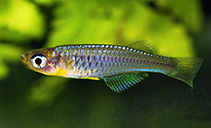| Diagnosis: |
Dorsal spines (total): 0-0; Dorsal soft rays (total): 7-8; Anal spines: 0-0; Anal soft rays: 15-17; Vertebrae: 30-30. Diagnosis: Hylopanchax thysi is distinguished from all other Hylopanchax species, except H. paucisquamatus, by the presence of 30 vertebrae vs. 31-33 (Ref. 123864). It is further distinguished from H. paucisquamatus and all congeners except H. multisquamatus by the presence of a hyaline urogenital male papilla with small black spots vs. black, and the presence of a conspicuous reticulate pattern in the flank of both males and females vs. absence or less conspicuous; finally, H. thysi is distinguished from H. multisquamatus by a male caudal peduncle depth-length ratio between 53-59% vs. 40-45%, 24-26 scales in the midlongitudinal series vs. 27-30, 13-14 pectoral-fin rays vs. 11-12, body depth 25.2-27.8% of standard length vs. 20.0-23.7%, female predorsal length between 62.0-64.0% of standard length vs. 66.0-74.8%, and female prepelvic length of 33.7-38.0% of standard length vs. 42.1-45.1% (Ref. 123864). Description: Dorsal profile slightly convex, becoming straight to concave at caudal peduncle; ventral profile convex from head to origin of anal fin, becoming straight to concave at anal-fin base and caudal peduncle; body laterally compressed, greatest body depth between pelvic and anal fins (Ref. 123864). Snout rounded, mouth directed upwards; lower jaw longer than upper jaw; on both jaws an outer row of enlarged, slightly curved conical teeth, inner teeth row irregularly arranged with small teeth; branchiostegal appendages present in adult males (Ref. 123864). Dorsal, anal and caudal fins truncate; pectoral fin approximately elliptical, tip reaching vertical between pelvic-fin base and urogenital papilla; pelvic fin short, tip not reaching anal-fin base; pelvic-fin bases in close proximity (Ref. 123864). Scales cycloid, body completely scaled except ventral head surface; dorsal- and anal-fin base without scales; longitudinal scales 24-26, transversal scales 6, scales around caudal peduncle 9-10 (Ref. 123864). Frontal head squamation G-type; one series of large infra-orbital scales; cephalic lateral line system: elongate and straight supra-orbital neuromast groove, medially delimited by a prominent lobe; anterior portion of supra-orbital sensory canal open in a shallow groove, with three neuromasts, posterior portion open in a shallow groove, with three neuromasts; anterior infra-orbital canal open, with two neuromasts; median portion of infra-orbital region with series of 9-11 minute neuromasts; posterior infra-orbital canal open in a shallow groove, with one neuromast; preopercular closed in dorsal and ventral portions, with five pores; mandibular canal represented by two neuromasts; in juveniles, all canals open (Ref. 123864). Second pharyngobranchial with five or six teeth; third pharyngobranchial wide, with well-developed dentigerous plate containing large conical, slightly curved teeth; fourth pharyngobranchial tooth plate with few small conical teeth; fourth ceratobranchial with two teeth; hypurals completely ankylosed; total vertebrae 30, 11 precaudal and 19 caudal; first proximal radial of dorsal fin between neural spine of vertebrae 15 and 16; first proximal radial of anal fin between pleural rib of vertebra 10 (Ref. 123864). Gill rakers on first branchiostegal arch 10-12; branchiostegal rays 5; anterior process of angulo-articular slightly downward directed; lachrymal guitar-shaped, anterior and posterior margins sharply curved (Ref. 123864). Colouration: Colouration in life of males: side of body is semi-transparent, with light blue iridescence; anterior region of flank with three rows of scales anteriorly edged with black crescent-shaped markings; head and snout light grey to yellowish brown in mature males; lower jaw grey brown; dorsum greyish blue, with strong blue to purple iridescence; venter light yellow between point just behind lower jaw and branchiostegal appendage; whitish grey from branchiostegal appendage insertion to pelvic fin; and bright greyish-blue iridescence between pelvic fin and caudal peduncle; pectoral-fin hyaline; pelvic-fin yellow; urogenital papilla with small black chromatophores; branchiostegal appendages membrane yellow; iris dorsal region iridescent blue; all unpaired fins are hyaline, with bright blue edges in juvenile males; in addition to the bright blue edges that are more inconspicuous in mature males, a bright green colouration is seen in the anal-fin proximal region (Ref. 123864). Colouration in life of females: side of body semi-transparent, with light-blue iridescence; anterior region of flank with three rows of scales anteriorly edged with black crescent-shaped markings; head, snout and lower jaw brownish grey; dorsum greyish blue, with light blue to green iridescence; venter white between point just behind lower jaw and urogenital papilla; greyish blue between urogenital papilla and caudal peduncle; all fins hyaline; narrow black band along base of anal fin; iris dorsal region iridescent blue (Ref. 123864). Colouration in alcohol: overall colouration of body pale-brownish yellow with sparsely distributed minute chromatophores; anterior region of flank with three or four rows of black crescent-shaped blotches on the anterior edge of scales, forming a reticulate pattern on flank; brown chromatophores on dorsum of head; melanophores on nape and along dorsal midline between nape and caudal-fin base; pale-brown chromatophores along whole midbody line of flank, more visible between pelvic-fin origin and caudal peduncle; melanophores forming a longitudinal stripe on ventral midline, between pelvic-fin base and caudal-fin base; head and jaws overall colouration yellowish brown; iris silver, darker close to pupil; dark pigment concentrated on dorsal margin of eye; all fins hyaline (Ref. 123864). |
